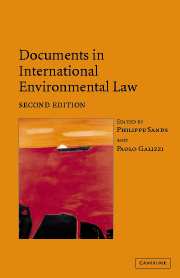Book contents
- Frontmatter
- Contents
- Preface
- PART I General instruments
- PART II Atmosphere
- 5 Convention on Long-Range Transboundary Air Pollution, 13 November 1979
- 5A Protocol to the 1979 Convention on Long-Range Transboundary Air Pollution on Further Reduction of Sulphur Emissions, 14 June 1994
- 5B Non-Compliance Procedure
- 6 Convention for the Protection of the Ozone Layer, 22 March 1985
- 6A Montreal Protocol on Substances that Deplete the Ozone Layer, 16 September 1987
- 6B Non-Compliance Procedure
- 7 United Nations Framework Convention on Climate Change, 9 May 1992
- 7A Kyoto Protocol to the United Nations Framework Convention on Climate Change, 11 December 1997
- 7B Marrakech Accords (extracts)
- PART III Oceans: global
- PART IIIB Oceans: regional
- PART IV Freshwater resources
- PART V Biodiversity
- PART VIA Hazardous substances and activities: nuclear
- PART VIB Hazardous substances and activities: pesticides
- PART VIC Hazardous substances and activities: waste
- PART VII Human rights and the environment
- PART VIII War and the environment
- PART IX Trade and the environment
- PART X Environmental impact assessment and access to information
- PART XI Liability for environmental damage and breaches of environmental obligations
- PART XII The Antarctic
6A - Montreal Protocol on Substances that Deplete the Ozone Layer, 16 September 1987
Published online by Cambridge University Press: 05 June 2012
- Frontmatter
- Contents
- Preface
- PART I General instruments
- PART II Atmosphere
- 5 Convention on Long-Range Transboundary Air Pollution, 13 November 1979
- 5A Protocol to the 1979 Convention on Long-Range Transboundary Air Pollution on Further Reduction of Sulphur Emissions, 14 June 1994
- 5B Non-Compliance Procedure
- 6 Convention for the Protection of the Ozone Layer, 22 March 1985
- 6A Montreal Protocol on Substances that Deplete the Ozone Layer, 16 September 1987
- 6B Non-Compliance Procedure
- 7 United Nations Framework Convention on Climate Change, 9 May 1992
- 7A Kyoto Protocol to the United Nations Framework Convention on Climate Change, 11 December 1997
- 7B Marrakech Accords (extracts)
- PART III Oceans: global
- PART IIIB Oceans: regional
- PART IV Freshwater resources
- PART V Biodiversity
- PART VIA Hazardous substances and activities: nuclear
- PART VIB Hazardous substances and activities: pesticides
- PART VIC Hazardous substances and activities: waste
- PART VII Human rights and the environment
- PART VIII War and the environment
- PART IX Trade and the environment
- PART X Environmental impact assessment and access to information
- PART XI Liability for environmental damage and breaches of environmental obligations
- PART XII The Antarctic
Summary
Editorial note
The 1987 Montreal Protocol to the Vienna Convention is the only Protocol to date adopted under the ozone layer treaty regime. The Montreal Protocol sets forth specific legal obligations, including limitations and reductions on the calculated levels of consumption and production of certain controlled ozone-depleting substances. Its negotiation and conclusion, shortly after the 1985 Vienna Convention, were prompted by new scientific evidence indicating that emissions of certain substances were significantly depleting and modifying the ozone layer and would have potential climatic effects (Preamble). The absence of scientific evidence that actual harm was occurring required the international community to take ‘precautionary measures to control equitably total global emissions’ of substances that deplete the ozone layer (Preamble).
The original text of the Montreal Protocol was adopted in 1987 and has been subsequently modified on several occasions. In 1990 the Second Meeting of the Parties to the Montreal Protocol adopted the first Adjustment and Amendments to the Montreal Protocol (London Adjustment and Amendment). The 1990 Montreal Protocol Amendments introduced important changes. The Preamble was amended to include reference to the need to take into account the ‘developmental needs of developing countries’, the provision of ‘additional financial resources and access to relevant technologies’, and the ‘transfer of alternative technologies’. The definition of ‘controlled substances’ and ‘production’ was amended (Article 1(4) and (5)), and a definition of ‘transitional substances’ was introduced (Article 1(9)). The amended definition of ‘production’ excludes ‘recycled’ and ‘reused’ amounts (Article 1(5)).
- Type
- Chapter
- Information
- Documents in International Environmental Law , pp. 82 - 124Publisher: Cambridge University PressPrint publication year: 2004
- 1
- Cited by



